I don’t know about you but I find composting hard. It is a statement that is frustrating given that I count myself among the hardcore, gardener, greenie, pro-compost, happy-to-recycle end of our society.
It’s not the actual process that is hard but it is the lifestyle change that you have to achieve in order to really commit to it that is a challenge. It is almost as bad as dieting — so hard to make the shift.
Consider that first you have to find a mechanism for collecting your organic waste inside your home that isn’t tedious, disgusting, ugly in its implementation or usually, all of the above. Then you have the new chore of regularly transporting said waste to the place where it is going to melt down into soil. Once it is there, you have another new chore — turning it, monitoring it and making sure that it is actually melting down properly. And finally — you get to use it — if you are a gardener.
In our house we struggle at every step. I’ve tried a variety of counter-top and under the sink collecting systems. They all have drawbacks that ultimately lead to an early demise. They are ugly, stinky, and worse – they create clutter in a place where I don’t have much space to begin with. The best, was a small white counter-top ceramic vessel, but it got dropped on the way to the compost heap one day and it hasn’t been replaced.
My compost heap in my vegetable garden — which is about 150 feet from my garage. Half the year it takes trudging through deep snow to get to it and the other half still involves a significant walk trudging a stinky heavy thing — it always draws complaints (particularly from my little people).
Our compost heap is rather large – it is constructed of 2 side by side bins made of recycled pallets – and it has never been turned or used. In every way – it is a big immovable heap. It is melting down, but there is always new stuff on top so the cooking process never seems to end. Maybe now that it is 3 + years old I will find the energy to dig the bottom out from under the top and make some use of what lies beneath. We will see – that sounds tedious and is going to involve significant physical exertion – so don’t hold your breath.
I have begun to consider a new heap — closer to the house that can be used for the next year or so until the old ones fully finish and maybe I can just rake them out — but working these production areas into a garden that you want to be really pretty is another trick. It all makes me want to throw up my hands — and I am pretty sure that most people who actually give this a go feel the same.
All this is to say that I think there needs to be a revolution in the composting industry. People need tools and systems that really work for modern life if they are actually going to pull their organic waste out from the rest of their garbage and create dirt nirvana. What we promote as industry professionals is just too tedious for the masses. Those big rolling things are expensive and ugly. Every system I’ve tried isn’t much of a system at all and they really only work for the hard core type ‘A’ composting people who just can’t imagine not going for a daily 5 mile run.
Enter Daily Dump — which is only in India, but I think it a huge step in the right direction — and one that I would love to see take hold in the USA. For under 10 dollars you can get some fairly attractive version of this.
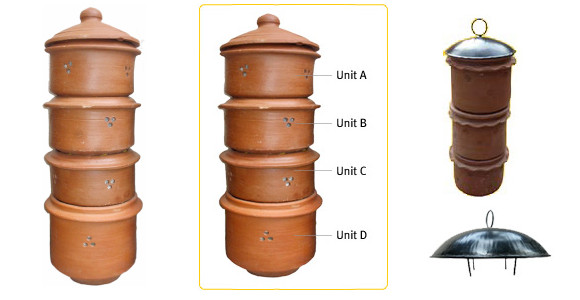
They are pretty, and can sit – attractively – right outside your door.
Here is a bit about how they work:

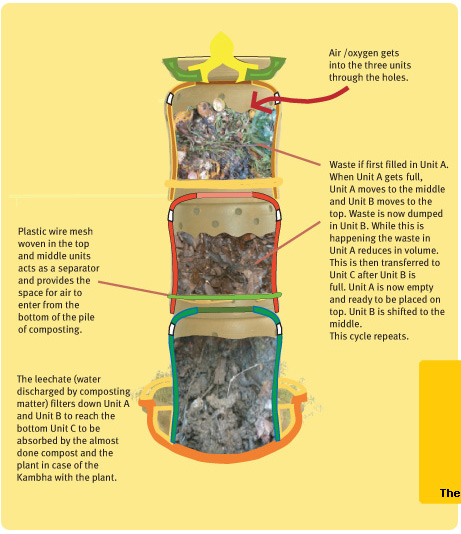 They suggest combining this with another system and you do each for 28 days (giving the composts time to melt down before switching to another method).
They suggest combining this with another system and you do each for 28 days (giving the composts time to melt down before switching to another method).
So you have Gamla pots (which feed your houseplants or patio pots) for 28 days, then you use your stackable Khamba Pots for 28 days, then if you need to, you use the public waste system for 28 days and then you cycle back through. It is a real system that creates usable amounts of compost in quantities that are reasonable for homeowners. 
I love the idea of being able to pull out a pot full of compost once a month to share with all my plant friends. This system feel much more manageable and lifestyle oriented. Kind of like the diet that only cuts out a daily soda and after a couple of months you have easily lost 10 lbs.
There is even a book for kids about the magic gamla pot. It takes kids through a journey where some materials in their own homes can turn into magic brown bits that have unique properties to make other things come to life. I want a magic Gamla pot.
I’m curious, do you think this type of thing could take hold in the US? What if Waste Management distributed Gamla pots and stacking Khamba pots in addition to those giant bins for collecting our paper and cans? Would you do it? Would your neighbors? I think it could be a revolution.
all images from Daily Dump
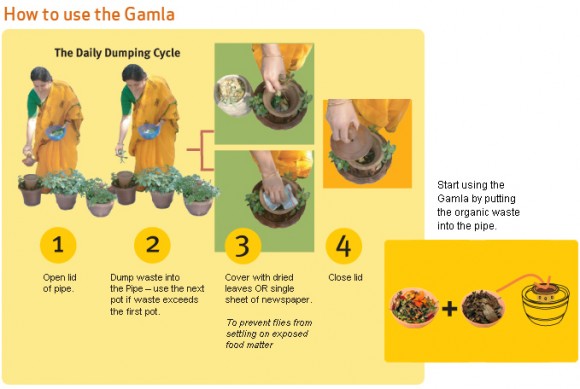
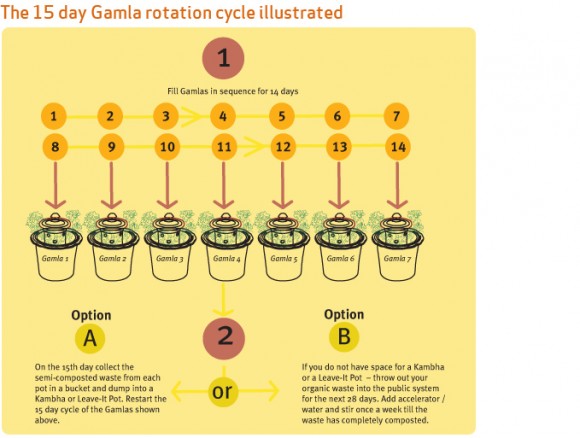
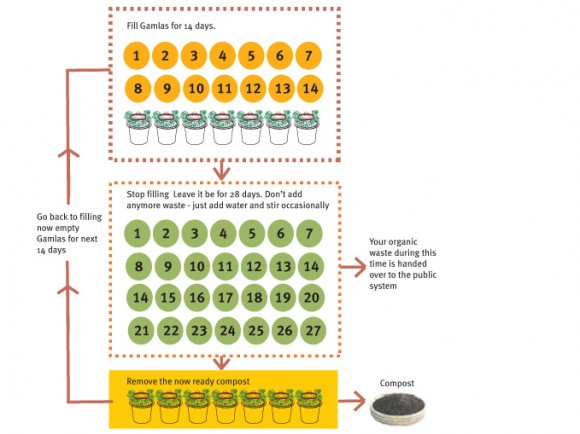
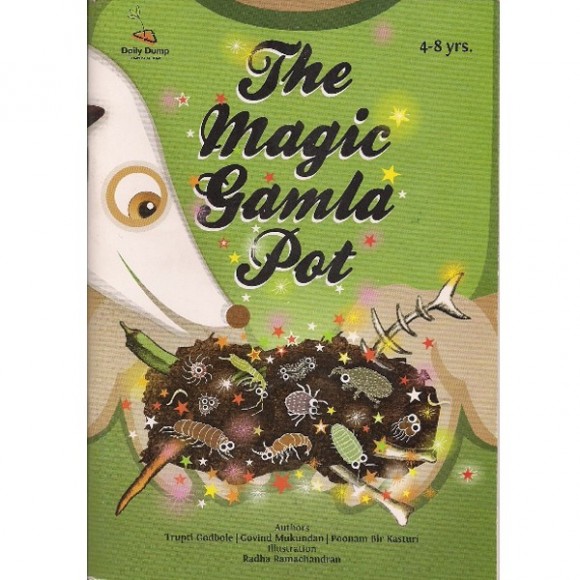
I really like the looks of this system and would totally consider it was available here. I have the composting ball, which seemed really good in concept but is actually a total pain. We keep it fairly close to the house but end up emptying it into the big compost pile behind our garage a couple of times a year. To be successful I think you really need a 3 bin solution. We are also considering vermiculture. The only downside is that I think it may need to go inside in the winter.
I too wanted to compost but knew the pile system would not fit into our lifestyle well. But I REALLY wanted the end product for my garden! We use the naturemill composter. http://www.naturemill.com/ Definitely not perfect, but after three years, I think we have a good system going, and the compost from it is awesome. I don’t keep it in the kitchen, but in an adjoining storage area, because it is a bit noisy while turning (about the noise level of a dishwasher). BUT it turns and heats the compost for you, which is HUGE. As a cheaper alternative, I like the above system, and would be interested to know if the winters would cause the ceramic to crack.
Rochelle,
I guess this set of pots would look better at the back door than what we have, but we still would have to have a pot inside to carry out to the composter wherever it is located. We have a large patio right out of the kitchen door and I don’t think I would want this set of pots on my patio. It is true that the amount of time to convert waste into compost can be quite long in a garden compost bin that is not turned, but we have found that whatever we dig out of the bottom of the bin and carry to the garden is gold. And I have read old wives tales that say to just bury the banana peel under and around the roses, no need to compost it in the first place.
So you might have found a good alternative for the trudge to your existing compost pile, and you are right that inventors and equipment builders need to produce better ways to make recycling easier, but the container inside is usually what surprises and dismays my friends and family from duplicating what we do, no matter how clean we SAY it is, or how UNSMELLY it is, the container really looks gross when they look inside it! BTW, we use a copper container purchased from Gardener’s Supply that we have dropped, rolled, etc. and it is still shiny copper on the outside and good to go after at least 5 to 8 years of use! Best to you,
Awesome site, thank you for sharing! I suspect the cycle they post would not happen as quickly in the US as it does in India. India is quite warm (well, most of it) so things just break down much quicker than they do in cooler weather in the US. I recently bought a black barrel composter and it said it “could” take only 30 days to make compost . . . 2 months later it still hasn’t gotten warm enough to do much and I live in a fairly temperate part of the US (pac nw). I struggle with compost too tho – I had a wooden palette system and it never seemed to break down even with vigorous turning. Tho I did check it after letting it just lie there for a year and it is lovely lovely soil . . . full of tree roots because the tree discovered it 😉
I agree with Amber. The decomposing of anything should be pretty fast in the indian climate, where sweat is such a common factor that people don’t mention it unless specifically talking about it. In UK, we have to use special techniques to make sure the compost bin stays hot. For example, I have painted my homemade bin pitch-black so that it can soak up as much heat as possible. But I do think in warmer parts of the US this product would be pretty useful, given that the cycle is streached suitably.